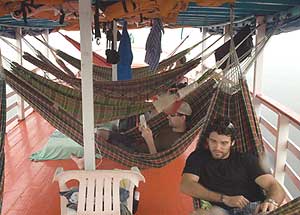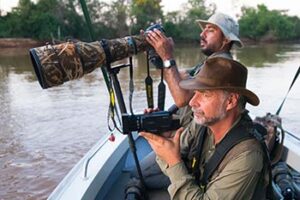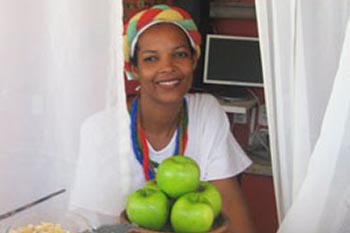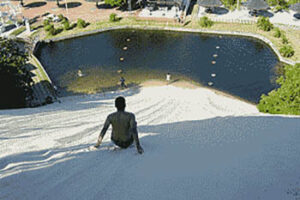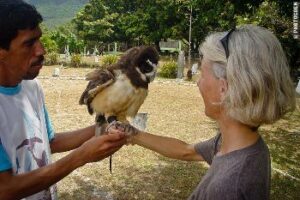Exploring the Archipelago Abrolhos: Five Tiny Islands Lost in the Atlantic Ocean
By Ekaterina Golovina
Finally, we left Salvador behind. We, meaning my friend, Chris, myself, and the captain of 37 foot-long yacht, the first mate and the only crew.
Five months of sailing by the islands of the Mediterranean and across the Atlantic Ocean – and we were among the palms of Brazil.
Bahia had received us warmly, but it was time to go south, towards Rio de Janeiro. The heart was longing to follow free wind again.
Way south
Well, here we were, literally waiting for this wind in the Southern Atlantic…
Three days at sea, and all of them – almost calm.
And rain. In the three days, we had gotten so thoroughly wet, as we hadn’t in 12, crossing from Cabo Verde to Brazil. The rain left us a rainbow – a graceful “excuse me” for the awful weather.
No one else was here – no dolphins, no birds. Even flying fish didn’t indulge us with their sparkling company, as it was all the way through the Atlantic.
We looked forward to arriving at the place, where hundreds of amazing creatures surrounded us day and night. We were on our way to the Islands of the archipelago Abrolhos, the marine park 70 kilometers from the Brazilian coast.
Mysterious fin
They appeared on the horizon. These five tiny islands are the creation of the coral reefs, the biggest one in the Southern Atlantic. It’s very shallow in the straights between them. Without electronic maps and sounding devices, we would have been in trouble.
These islands are a natural reserve but there are no crowds of tourists, hungry for marine wonders. Even the private boats avoid this place. Why? We will understand very soon.
The only inhabitants of the archipelago are two people, representatives of the Brazilian Navy. They live on the biggest island of the archipelago Ilha de Santa Barbara and take care of the local lighthouse.
Here we are, anchored and ready to dive. Honestly, I feel scared. Don’t get me wrong, I’m a good swimmer and love all of the creations of Mother Nature. But I have my reasons.
At arrival, Chris exclaimed, “Look! A fin! And quite a big one!”
“Where?!” I was up in a quarter of a second. “Where?!” I arrived late. “What was that?”
“A shark?” guessed Chris with an innocent expression. I’m fond of sharks, especially after my cage-diving experience in South Africa. But better we swim in separate pools.
Diving with a little shark
We are “parked” right after a little shallow, literally in the straight. Beautiful view, but twice a day we suffer, and even the beauty of the scenery doesn’t bring us joy… and here’s the reason why so few boats stop at this seemingly magical place.
There is no shelter bay in Abrolhos, and twice a day we have to experience the power of the tide. It moves the boat fiercely, and that’s not a kind of swing that a mother applies to her baby’s cradle. If during the day we are able to escape to sea diving, at night we have to wait sleeplessly until it’s finished.
Nevertheless, local nature is absolutely worth the inconvenience.
Tropical fishes scurry around, not too worried about new clumsy and curious species. For three days Chris and I turn into marine creatures, with masks and snorkels spending hours in cool Atlantic waters, not able to take our eyes off of treasures of the reef.
I get into a narrow strait next to our anchorage soaring in water, admiring colors and feeling the careful touch of the tide. Suddenly, a sharp snout appears in front of me! As if from nowhere! A long silvery fish is staring at me, still in the water. That’s a barracuda. It has come to check who has crossed onto its territory.
“Wow,” I would say if I could do that underwater. Even here, fish scales shine in scarce sunbeams that fight their way from the surface.As if trying to impress me more, the barracuda opens its mouth. I see rows of small but very sharp teeth. Quite a “smile,” but better I get out of here!
Later, the ranger told me the place I was diving is known as the Straight of Barracuda.
“We call it ‘pequeno tubarao’ (a little shark), and they are quite territorial. Take care, it might bite an invader,” he warned.
A turtle gives me a ride
I felt thrilled to dive down into caves.
“There’s a big one down there. Let’s go check!” That’s Chris.
We dive. Occupied! By a fish half my body size! That’s a Brazilian Merou. I start back but the giant has as much desire to get out as I do to enter his watery realm.
By the way, the secret of a mysterious fin has been discovered. Most likely, that was a turtle! Swimming around their little paradise, they leisurely spin in water, first rising to the sun their left flipper, then right… left… right…
I want to “get a ride” from a sea turtle. I apply a strategy here. First I sit in the cockpit waiting for one to raise her head or flipper close enough to the boat.
As soon as it arrives, I slip quietly into the water. The secret is not to make splashes. Any harsh movement – and the turtle is gone.
The huge reptile doesn’t mind me swimming side by side and even touching her shell. And so we hover in water together, like birds in flowing air.
The Dating and Mating Island
By the way, birds – there are thousands of them around! They cross the sky day and night, swooping down to the water in sight of a fish. We stay close to the island Siriba, the only one open for visitors.
It sounds like a Turkish bazaar. There are only four bird species that live on the islands: the white-bellied booby, the pilot, the magpie, and the frigate bird. The other 22 arrive for mating purposes and now the season is at its peak.
On Siriba we are following a narrow pass, carefully stepping around birds that nest on a trail. Feathered inhabitants don’t mind our presence, showing vivid interest in only their private lives.
Mothers guard their babies, hardly covered by floccus. Males chase females. A couple of birds on the rocks are dining on fresh catch. Community life follows its course.
In July baleias-jubarte – humpback whales arrive to the archipelago. They stay there until November, busy with newly born calves. A good reason for us to come back to the tiny archipelago in the Southern Atlantic.

Ekaterina Golovina is a professional writer and editor and has written for GoNomad about a journey on the yacht Scorpius. She has been traveling and living on board yachts for several years. Once she hopped on a sailing boat in Italy, to find herself in Brazil five months later.
- Missouri Sports Travel Adventure: From Landmarks to Ballparks - January 21, 2026
- What First-Time Visitors Get Wrong About Visiting Iceland - January 15, 2026
- Bareboat Charter vs all-inclusive Crewed: Which Luxury Charter Fits You? - December 29, 2025


